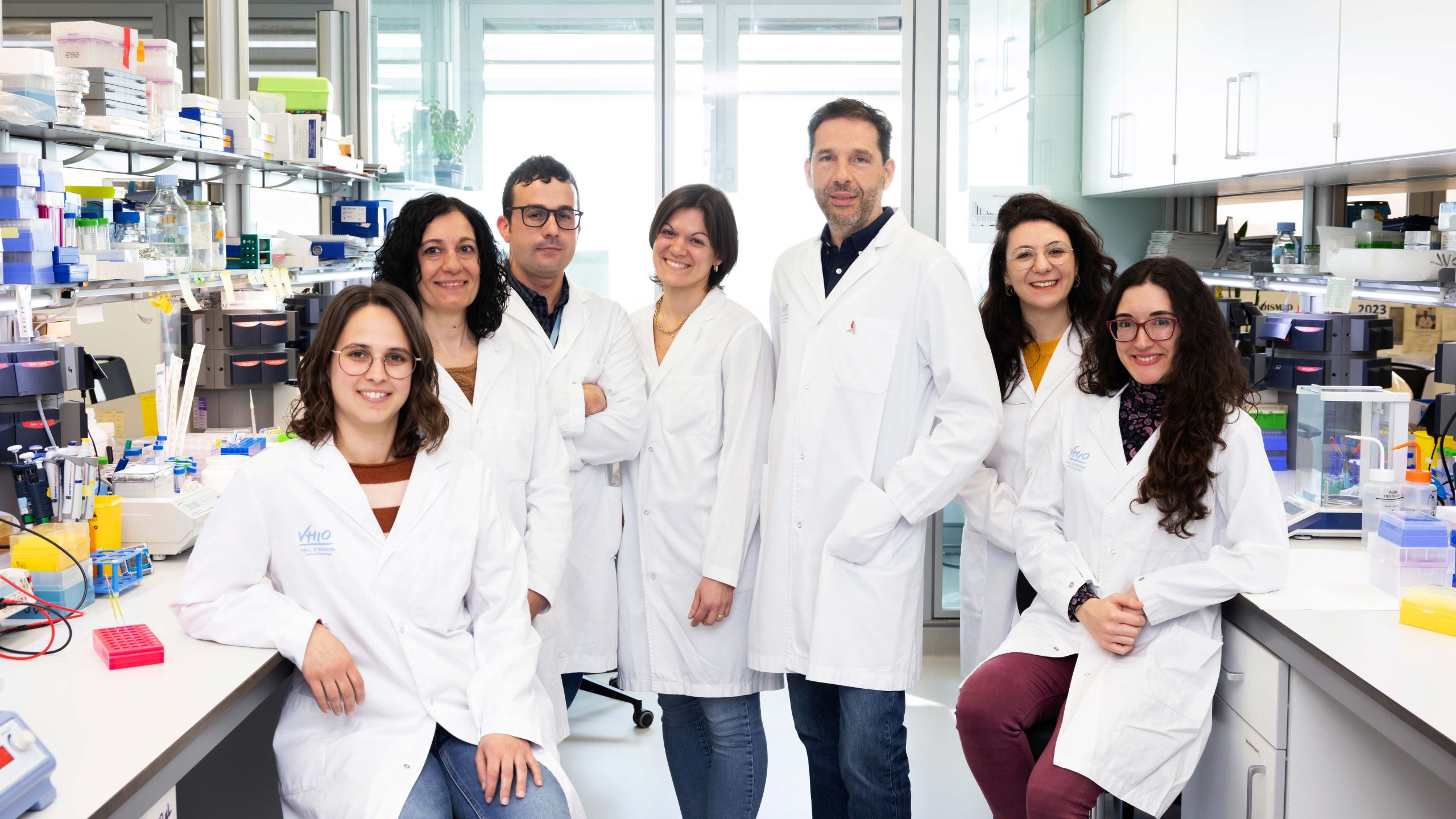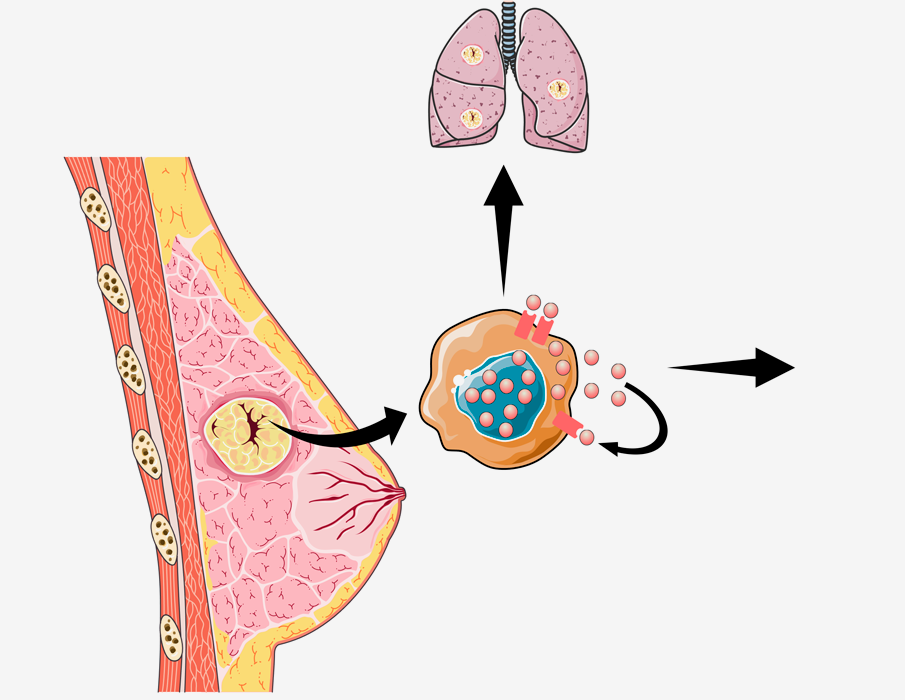
La comunicación de las células tumorales con su microentorno desempeña un papel importante en el inicio y la progresión del tumor. Las células cancerosas secuestran el ecosistema del microentorno tumoral con la señalización paracrina para promover un microentorno prooncogénico crucial para el desarrollo de tumores primarios y metastásicos.
Nuestro principal objetivo es caracterizar los mecanismos adoptados por estas células para comunicarse entre sí y con su microentorno durante la oncogénesis. Nuestro objetivo es explotar estos datos para avanzar en el descubrimiento de biomarcadores y dianas farmacológicas.
Nuestro enfoque metodológico se centra en el perfil proteómico cuantitativo de subproteomas vinculados a la comunicación celular, incluidos el secretoma, los exosomas y el proteoma de la superficie celular. En los últimos años, nuestro laboratorio ha pasado de estudiar la proteómica del cáncer mediante un enfoque basado en datos a interrogar la comunicación de las proteínas de las células tumorales mediante un enfoque basado en hipótesis. A través de estos estudios, hemos demostrado que una función extracelular alternativa de la proteína nuclear HMGA1 media la invasión tumoral y la metástasis en el cáncer de mama triple negativo (TNBC) al convertirse en un ligando para el Receptor para el producto final de glicación avanzada (RAGE).
También estamos involucrados en la identificación de biomarcadores de respuesta y mecanismos de resistencia para nuevas terapias utilizadas en la clínica para tratar pacientes con TNBC. En un proyecto reciente destinado a identificar biomarcadores de eribulina basados en secretoma, caracterizamos las células persistentes tolerantes a fármacos (DTP) generadas por agentes quimioterapéuticos e identificamos GDF15 como un biomarcador específico para DTP que también tiene un papel en su supervivencia. Nuestros datos también muestran que las células DTP que sobreviven a una dosis alta de fármacos citotóxicos darán lugar a diferentes mecanismos de resistencia estables.
- Caracterizar el papel de RAGE en la invasión y metástasis de TNBC.
- La identificación y caracterización de los mecanismos de respuesta y resistencia adquirida a las terapias actuales en cáncer de mama.
- El desarrollo e implementación de metodologías proteómicas destinadas a comprender la comunicación celular en la biología del cáncer.

Figura: Papel de la vía extracelular HMGA1-RAGE en el cáncer de mama triple negativo (CMTN). El establecimiento de un bucle autocrino HMGA1-RAGE en las células del CMTN incrementa su fenotipo migratorio e invasivo y guarda relación con una mayor incidencia de la metástasis distante en pacientes con CMTN. Méndez et al. Int J Mol Sci. 2019. 20(23), 5950.
Jefe de grupo
Josep Villanueva
Becaria postdoctoral
Chiara Bellio
Estudiante de postgrado
Mireia Pujals
Técnicos
Marta Emperador
José Ángel Robles
Ferran Soler
Publicaciones científicas más relevantes
- Juliachs M, Pujals M, Bellio C, Meo-Evoli N, Duran JM, Zamora E, Parés M, Suñol A, Méndez O, Sánchez-Pla A, Canals F, Saura C, Villanueva J. Circulating SOD2 Is a Candidate Response Biomarker for Neoadjuvant Therapy in Breast Cancer. Cancers (Basel). 2022 Aug 10;14(16):3858.
- Bellio C, Emperador M, Castellano P, Gris-Oliver A, Canals F, Sánchez-Pla A, Zamora E, Arribas J, Saura C, Serra V, Tabernero J, Littlefield BA, Villanueva J. GDF15 Is an Eribulin Response
- Pujals M, Resar L, Villanueva J. HMGA1, Moonlighting Protein Function, and Cellular Real Estate: Location, Location, Location! Biomolecules. 2021 Sep 9;11(9):1334.
- Méndez O, Pérez J, Soberino J, Racca F, Cortés J, Villanueva J. Clinical Implications of Extracellular HMGA1 in Breast Cancer. Int J Mol Sci. 2019. 20(23), 5950.
- Méndez O, Peg V, Salvans C, Pujals M, Fernández Y, Abasolo I, Pérez J, Matres A, Valeri M, Gregori J, Villarreal L, Schwartz S Jr, Ramon Y Cajal S, Tabernero J, Cortés J, Arribas J, Villanueva J. Extracellular HMGA1 Promotes Tumor Invasion and Metastasis in Triple-Negative Breast Cancer. Clin Cancer Res. 2018 Dec 15;24(24):6367-6382
- Méndez O, Villanueva J. Challenges and opportunities for cell line secretomes in cancer proteomics.Proteomics Clin Appl. 2015;9(3-4):348-357.
- Katsila T, Juliachs M, Gregori J, Macarulla T, Villarreal L, Bardelli A, Torrance C, Elez E, Tabernero J, Villanueva J. Circulating pEGFR is a candidate response biomarker of cetuximab therapy in colorectal cancer. Clin. Cancer Res. 2014 Dec; 20(24): 6346-56
- Villarreal L, Méndez O, Salvans C, Gregori J, Baselga J, Villanueva J*. Unconventionalsecretion is a major contributor of cancer cell line secretomes. Mol Cell Proteomics. 2013, 12(5):1046-60.
- Gregori J, Méndez O, Katsila T, Pujals M, Salvans C, Villarreal L, Arribas J, Tabernero J, Sánchez A, Villanueva J. Enhancing the Biological Relevance of Secretome-Based Proteomics by Linking Tumor Cell Proliferation and Protein Secretion. J. Proteome Res. 2014 Jul;
- Gregori J, Villarreal L, Sánchez A, Baselga J, Villanueva J. An effect size filter improves the reproducibility in spectral counting-based comparative proteomics. J Proteomics 2013 Dec; 95: 55-65
- Gregori J, Villarreal L, Méndez O, Sánchez A, Baselga J, Villanueva J. Batch effects correction improves the sensitivity of significance tests in spectral counting-based comparative discovery proteomics. J Proteomics 2012 Jul; 75(13): 3938-51
- Lawlor K, Nazarian A, Lacomis L, Tempst P, Villanueva J*. Pathway-based biomarker search by high-throughput proteomics profiling of secretomes. J Proteome Research. 2009. 8(3):1489-503.
Todas las publicaciones
- Juliachs M, Pujals M, Bellio C, Meo-Evoli N, Duran JM, Zamora E, Parés M, Suñol A, Méndez O, Sánchez-Pla A, Canals F, Saura C, Villanueva J. Circulating SOD2 Is a Candidate Response Biomarker for Neoadjuvant Therapy in Breast Cancer. Cancers (Basel). 2022 Aug 10;14(16):3858.
- Bellio C, Emperador M, Castellano P, Gris-Oliver A, Canals F, Sánchez-Pla A, Zamora E, Arribas J, Saura C, Serra V, Tabernero J, Littlefield BA, Villanueva J. GDF15 Is an Eribulin Response
- Pujals M, Resar L, Villanueva J. HMGA1, Moonlighting Protein Function, and Cellular Real Estate: Location, Location, Location! Biomolecules. 2021 Sep 9;11(9):1334.
- Méndez O, Pérez J, Soberino J, Racca F, Cortés J, Villanueva J. Clinical Implications of Extracellular HMGA1 in Breast Cancer. Int J Mol Sci. 2019, 20(23), 5950.
- Arreal L, Piva M, Fernández S, Revandkar A, Schaub-Clerigué A, Villanueva J, Zabala-Letona A, Pujana M, Astobiza I, Cortazar AR, Hermanova I, Bozal-Basterra L, Arruabarrena-Aristorena A, Crespo JR, Valcarcel-Jimenez L, Zúñiga-García P, Canals F, Torrano V, Barrio R, Sutherland JD, Alimonti A, Martin-Martin N, Carracedo A.Targeting PML in triple negative breast cancer elicits growth suppression and senescence. Cell Death Differ. 2019 Oct 1. doi: 10.1038/s41418-019-0407-5.
- Méndez O, Peg V, Salvans C, Pujals M, Fernández Y, Abasolo I, Pérez J, Matres A, Valeri M, Gregori J, Villarreal L, Schwartz S Jr, Ramon Y Cajal S, Tabernero J, Cortés J, Arribas J, Villanueva J. Extracellular HMGA1 Promotes Tumor Invasion and Metastasis in Triple-Negative Breast Cancer. Clin Cancer Res. 2018 Dec 15;24(24):6367-6382
- Zacarias-Fluck MF, Morancho B, Vicario R, Luque Garcia A, Escorihuela M, Villanueva J, Rubio IT, Arribas J. Effect of cellular senescence on the growth of HER2-positive breast cancers. J. Natl. Cancer Inst. 2015 May; 107(5)
- Morancho B, Martínez-Barriocanal Á, Villanueva J, Arribas J. Role of ADAM17 in the non-cell autonomous effects of oncogene-induced senescence. Breast Cancer Res. 2015; 17: 106
- Katsila T, Juliachs M, Gregori J, Macarulla T, Villarreal L, Bardelli A, Torrance C, Elez E, Tabernero J, Villanueva J. Circulating pEGFR is a candidate response biomarker of cetuximab therapy in colorectal cancer. Clin. Cancer Res. 2014 Dec; 20(24): 6346-56
- Nazarian A, Lawlor K, Yi SS, Philip J, Ghosh M, Yaneva M, Villanueva J, Saghatelian A, Assel M, Vickers AJ, Eastham JA, Scher HI, Carver BS, Lilja H, Tempst P. Inhibition of circulating dipeptidyl peptidase 4 activity in patients with metastatic prostate cancer. Mol. Cell Proteomics 2014 Nov; 13(11): 3082-96
- Gregori J, Méndez O, Katsila T, Pujals M, Salvans C, Villarreal L, Arribas J, Tabernero J, Sánchez A, Villanueva J. Enhancing the Biological Relevance of Secretome-Based Proteomics by Linking Tumor Cell Proliferation and Protein Secretion. J. Proteome Res. 2014 Jul;
- Segura V, Medina-Aunon JA, Mora MI, Martínez-Bartolomé S, Abian J, Aloria K, Antúnez O, Arizmendi JM, Azkargorta M, Barceló-Batllori S, Beaskoetxea J, Bech-Serra JJ, Blanco F, Monteiro MB, Cáceres D, Canals F, Carrascal M, Casal JI, Clemente F, Colomé N, Dasilva N, Díaz P, Elortza F, Fernández-Puente P, Fuentes M, Gallardo O, Gharbi SI, Gil C, González-Tejedo C, Hernáez ML, Lombardía M, Lopez-Lucendo M, Marcilla M, Mato JM, Mendes M, Oliveira E, Orera I, Pascual-Montano A, Prieto G, Ruiz-Romero C, Sánchez del Pino MM, Tabas-Madrid D, Valero ML, Vialas V, Villanueva J, Albar JP, Corrales FJ. Surfing transcriptomic landscapes. A step beyond the annotation of chromosome 16 proteome. J. Proteome Res. 2014 Jan; 13(1): 158-72
- Gregori J, Villarreal L, Sánchez A, Baselga J, Villanueva J. An effect size filter improves the reproducibility in spectral counting-based comparative proteomics. J Proteomics 2013 Dec; 95: 55-65
- Angelini PD, Zacarias Fluck MF, Pedersen K, Parra-Palau JL, Guiu M, Bernadó Morales C, Vicario R, Luque-García A, Navalpotro NP, Giralt J, Canals F, Gomis RR, Tabernero J, Baselga J, Villanueva J, Arribas J. Constitutive HER2 signaling promotes breast cancer metastasis through cellular senescence.Cancer Res. 2013 Jan; 73(1): 450-8
- Gregori J, Villarreal L, Méndez O, Sánchez A, Baselga J, Villanueva J. Batch effects correction improves the sensitivity of significance tests in spectral counting-based comparative discovery proteomics. J Proteomics 2012 Jul; 75(13): 3938-51
- Sánchez A, Villanueva J. PI3K-based molecular signatures link high PI3K pathway activity with low ER levels in ER+ breast cancer. Expert Rev Proteomics 2010 Dec; 7(6): 819-21
- Villanueva J, Nazarian A, Lawlor K, Tempst P. Monitoring peptidase activities in complex proteomes by MALDI-TOF mass spectrometry. Nat Protoc 2009; 4(8): 1167-83
- Lawlor K, Nazarian A, Lacomis L, Tempst P, Villanueva J. Pathway-based biomarker search by high-throughput proteomics profiling of secretomes. J. Proteome Res. 2009 Mar; 8(3): 1489-503
- Villanueva J, Nazarian A, Lawlor K, Yi SS, Robbins RJ, Tempst P. A sequence-specific exopeptidase activity test (SSEAT) for “functional” biomarker discovery. Mol. Cell Proteomics 2008 Mar; 7(3): 509-18
- Villanueva J, Philip J, DeNoyer L, Tempst P. Data analysis of assorted serum peptidome profiles. Nat Protoc 2007; 2(3): 588-602
- Villanueva J, Lawlor K, Toledo-Crow R, Tempst P. Automated serum peptide profiling. Nat Protoc 2006; 1(2): 880-91
- Villanueva J, Martorella AJ, Lawlor K, Philip J, Fleisher M, Robbins RJ, Tempst P. Serum peptidome patterns that distinguish metastatic thyroid carcinoma from cancer-free controls are unbiased by gender and age. Mol. Cell Proteomics 2006 Oct; 5(10): 1840-52
- Villanueva J, Shaffer DR, Philip J, Chaparro CA, Erdjument-Bromage H, Olshen AB, Fleisher M, Lilja H, Brogi E, Boyd J, Sánchez-Carbayo M, Holland EC, Cordon-Cardo C, Scher HI, Tempst P. Differential exoprotease activities confer tumor-specific serum peptidome patterns. J. Clin. Invest. 2006 Jan; 116(1): 271-84
- Villanueva J, Philip J, Entenberg D, Chaparro CA, Tanwar MK, Holland EC, Tempst P. Serum peptide profiling by magnetic particle-assisted, automated sample processing and MALDI-TOF mass spectrometry. Anal. Chem. 2004 Mar; 76(6): 1560-70
- Diagnostic and Therapeutic implications of the HMGA1-RAGE signaling pathway in Triple Negative Breast Cancer. Funding Agency: Instituto de Salud Carlos III (ISCIII). 2020 – 2022.
- El microambient immune tumoral en la patogènesi i control del linfoma de cèl.lules del mantell. Funding Agency: Fundació La Marató de TV3 2020-2022.
- We are part of CIBERONC’s Programa de Tumores del Tracto Digestivo, as part of the group (Program ID: CB16/12/00259) led by VHIO’s Director and Head of our Gastrointestinal & Endocrine Tumors Group, Josep Tabernero (PI: Teresa Macarulla).











